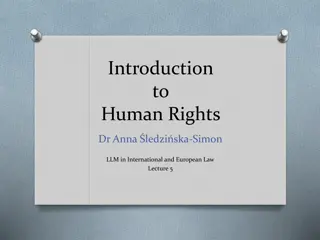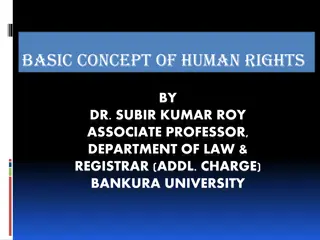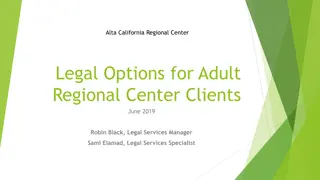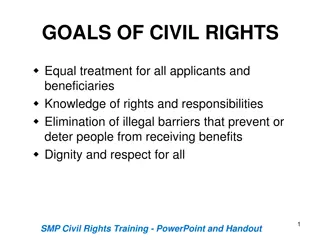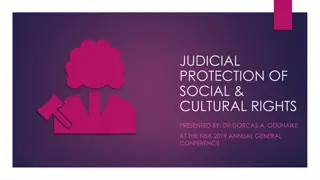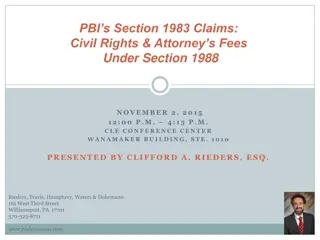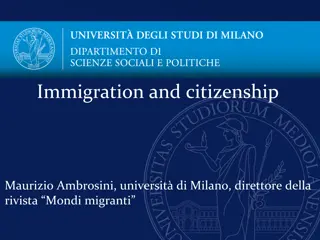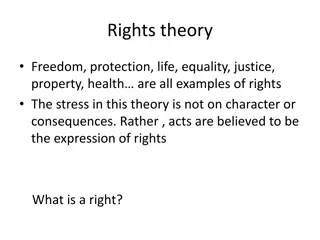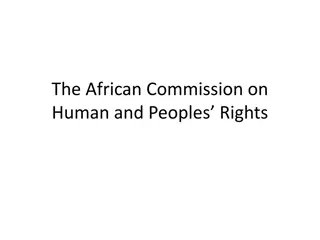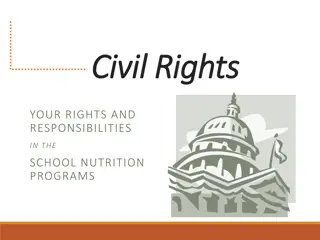Understanding Rights: Definitions and Importance
Rights are essential entitlements recognized and enforceable by law, shaping governments, laws, and morality. Various definitions by legal scholars highlight the nature and importance of rights in society, emphasizing the relationship between rights and duties. Understanding rights is crucial for upholding justice and creating a harmonious social order.
Download Presentation

Please find below an Image/Link to download the presentation.
The content on the website is provided AS IS for your information and personal use only. It may not be sold, licensed, or shared on other websites without obtaining consent from the author. Download presentation by click this link. If you encounter any issues during the download, it is possible that the publisher has removed the file from their server.
E N D
Presentation Transcript
Rights By Dr Pramod Kumar
Introduction Just as we require food, clothing and goods affording the conveniences of living, we need rights also. Rights recognized and enforceable at law. As a legal term, it means the Standard of permitted action by law . Such permitted action of a person is known as his legal right.
Introduction Rights are entitlements (not) to perform certain actions, or (not) to be in certain states; or entitlements that others (not) perform certain actions or (not) be in certain states. Rights dominate modern understandings of what actions are permissible and which institutions are just. Rights structure the form of governments, the content of laws, and the shape of morality as many now see it. To accept a set of rights is to approve a distribution of freedom and authority, and so to endorse a certain view of what may, must, and must not be done.
Definitions of Right According to Austin- Rights is a faculty which resides in a determinate party or parties by virtue of a given law and which avails against a party or parties other than the party or parties in whom it resides. According to him- a person can be said to have a right only when another or others are bound or obliged by law to do something or forbear in regard to him. It means that a right has always a corresponding duty.
Definitions of Right According to Holland:- Legal Right as the ability possessed by a person to control others actions, with the assent and assistance of the State . Thus, Holland follows the definition given by the Austin. According to Kohler:- A legal right is a relation sanctioned and protected by the legal order
Definitions of Right According to T. H. Green:- Rights are powers necessary for the fulfillment of man s vocation as a moral being. According to Laski:- Rights are those conditions of social life without which no man can seek in general, to be himself at his best.
Definitions of Right According to Salmond:- A right is an interest recognised and protected by a rule of right(rule of law) . It is an interest, respect for which a duty and disregard of which is a wrong. Thus, a right must be judicially enforceable. According to Kelson:- there is no conception as right in law According to Duguit:- no one has any other right than always to do his duty
Definitions of Right Indian Supreme Court: In State of Rajasthan v. Union of India(AIR 1977 SC 1361), The Court observed: In a strict sense, legal rights are correlative of legal duties and are defined as interests which the law protects by corresponding duties on others. But in a generic sense, the word right is used to mean an immunity from the legal power of another.
Natural Rights Natural rights are rights which are natural in the sense of not artificial, not man-made , as in rights deriving from human nature or from the edicts of a god. They are universal; that is, they apply to all people, and do not derive from the laws of any specific society. They exist necessarily, inhere in every individual, and can't be taken away. For example, it has been argued that humans have a natural right to life. These are sometimes called moral rights or inalienable rights.
Legal Rights Legal rights, in contrast, are based on a society's customs, laws, statutes or actions by legislatures. An example of a legal right is the right to vote of citizens. Citizenship, itself, is often considered as the basis for having legal rights, and has been defined as the right to have rights . Legal rights are sometimes rights or statutory rights and are culturally and politically relative since they depend on a specific societal context to have meaning. called civil
Types of Legal Right Legal Rights are of three types: 1. Civil Rights: Civil rights are those rights which provide opportunity to each person to lead a civilized social life. These fulfill basic needs of human life in society. Right to life, liberty and equality are civil rights. Civil rights are protected by the state.
Types of Legal Right 2. Political Rights: Political rights are those rights by virtue of which citizens get a share in the political process. These enable them to take an active part in the political process. These rights include right to vote, right to get elected, right to hold public office and right to criticize and oppose the government. Political rights are really available to the people in a democratic state.
Types of Legal Right 3. Economic Rights: Economic rights are those rights which provide economic security to the people. These enable all citizens to make proper use of their civil and political rights. The basic needs of every person are related to his food, clothing, shelter, medical treatment etc. Without the fulfillment of these no person can really enjoy his civil and political rights. It is therefore essential, that every person must get the right to work, right to adequate wages, right to leisure and rest, and right to social security in case of illness, physical disability and old age
Classification of Legal Rights Legal rights have been classified by various jurists in different ways. Rights may generally be classified under the following heads: 1. Perfect & Imperfect Rights The perfect right has the following features: It is recognized by law. It is enforceable by law. So, in the case of breach of this right, a person may go to court for enforcing this right. Thus, all fundamental rights, viz. Right to equality, right to religion, etc. are perfect rights as these are enforceable by law. The imperfect right has the following features: It is recognized by law. It is not enforceable by law. This means that a person cannot go to court for the breach of imperfect right. All the time-bound claims or debts come under the category of imperfect rights.
Classification of Legal Rights 2. Positive & Negative Rights The basis of distinguishing right as positive or negative is the nature of correlative duty it carries with it. Under Positive rights, the person has to perform some positive duty to fulfill this right. Negative rights prevent a person to do some act, that is it corresponds to a negative duty. Example: Right to life under article 21 of the Indian constitution is a negative right because it prevents a person to kill another person.
Classification of Legal Rights 3. Real & Personal Rights Real right or right in-rem corresponds to the duty imposed upon the people in general. It is available against the whole world in general. Example: Tort or crime is a real right. Personal right or right in-persona is available against a particular person & it corresponds to duty the duty imposed upon a particular person. Therefore, the personal right generally arises out of contractual obligation. Example: breach of contract is a personal right.
Classification of Legal Rights 4. Proprietary & Personal Rights A proprietary right is available with respect to a property that is it relates to the owner & his assets. The assets must have some monetary value. Example: the right to ownership of property, Right to patent, Right to goodwill, etc. A personal right is related to a person s life i.e. his reputation or standing in the society. These rights promote a person s well being in society & have no economic value. Example: Right to life.
Classification of Legal Rights 5. Public & Private Rights The rights which are vested in a person by state or govt. or constitution is called public rights. Example: Right to vote, Right to use public parks, etc. Private rights are connected individuals or persons. Example: A contract entered into by two people gives rise to private rights to them. with private
Classification of Legal Rights 6. Inheritable & Uninheritable Rights Inheritable rights can be passed from one generation to another, i.e. this right survives even after the death of its owner. Example: A son is a legal heir to the property of his father after his death. Uninheritable rights die with the death of its owner. Example: All personal rights are uninheritable rights.
Classification of Legal Rights 7. Right in repropria & Right in realiena A person possesses Right in repropria with respect to his own property. He can use, dispose of, destroy, modify or exclude others from his property. Thus, this right gives a person, absolute ownership over the property. Right in realiena is the right in the property of another person. Example: Right of way over the neighbor s field. So, it is not an absolute right.
Classification of Legal Rights 8. Principal and Accessory Rights Principal rights exist independently of other rights. Accessory rights are ancillary to principle rights and have a beneficial effect on the principal rights. Example: if a debt is secured by a mortgage, the recovery of debt is the principle right while the security is the accessory rights. The easements annexed with the land, and the easementary rights are accessory rights. The right of way is the accessory right. The tenant of the building has the accessory right on the building
Classification of Legal Rights 9. Primary and Sanctioning Rights(Antecedent and Remedial Rights) Primary rights are also called the antecedent or substantive rights. Similarly Sanctioning rights are also called the remedial or adjective rights. A sanctioning right is one which arises out of the violation of another right. My right not to be damaged is primary right but my right to obtain compensation on such damage is sanctioning right.
Classification of Legal Rights 10. Vested and contingent right Vested right is complete right. It must be vest to person entitled. It is not dependent on any uncertain event. Contingent rights are such right which depends upon any uncertain event and right will vest on happening or not happening (what case may be) of event. Example right of life is vest right but my right to get a car if I marry to D it is contingent right.
Theories of Legal Right There are two main theories regarding nature of legal rights. They are: 1. Will Theory 2. Interest Theory 1. Will Theory: According to this theory, a right is an interest attribute of the human will. The subject matter of right is derived from human will. The theory suggests that it is through a right that a man express his will over an object. The theory has also been accepted by historical jurists of Germany. The definition of right given by Austin and Holland lay down that will is the main element of a right. A strong support to the theory has been given by doctrines of natural rights. Puchta defined legal right as a power over an object which by means of this rights be subjected to will of the person enjoying the right . However, Paton said: Will is an essential element in the general conception of legal right, but it is not the only element. Duguit suggests that will is not an essential element of a legal right of law. The real basis of law is social solidarity. The will theory has been supported by Hegal, Kant, Hume and others.
Theories of Legal Right 2. Interest Theory Interest Theory was propounded by the German Jurist Ihering. Ihering defines legal right as a legally protected interest . According to him, the basis of right is interest and not will . Law always has a purpose. In case of rights the purpose of law in to protect certain interests and not the wills of individuals. Salmond also supported Ihering s views. The Interest theory is supported on the ground that there are cases where a person may have rights without having any will . Infants, lunatics and corporations have a legal rights but they do not have wills. However, it may be noted that in all these cases a will is operative, i.e. of the guardian of the infant, or the lunatic, or the members of the corporations.
The Elements/characteristics of a Legal Right According to Salmond: There are five elements or characteristics of a legal right: i) The subject of the person of inherence: Subject means the person in whom the right is vested, or the holder of right. Thus there can not be a legal right without a subject or a person who owns it. However, the owner of the right need not be certain or determinate. For example, an unborn child possesses a legal right although it is not certain whether he would be born alive or not. Likewise, a right can be owned by the society at large, it is a valid right although the subject of right is indeterminate. ii) The person bound or the person of incidence: It means the person upon whom falls the correlative duty. He is a person bound by the duty and so may be described as subject of the duty .
The Elements/characteristics of a Legal Right iii) The act of forbearance: Right relates to some act to forbearance. It obliges a person to act or forbear in favour of the person who is entitled to the right. It is the content of the right. iv) The object of right : It is the thing in respect of which the right exists or is exercised. The object or subject matter of right may be material or immaterial, determinate or indeterminate. v) Title: Every legal right has a title, i.e. certain facts or events by reason of which the right has become vested in the owner.
Difference between Fundamental Rights and Legal Rights The legal rights are protected by an ordinary law, but they can be altered or taken away by the legislature by changing that law. Rights are protected and Guaranteed by the Constitution and they cannot be taken away by an ordinary law enacted by the legislature. If a legal right of a person is violated, he can move to an ordinary court, but if a fundamental right is violated the Constitution provides that the affected person may move to High court or Supreme Court. Fundamental
Difference between Fundamental Rights and Legal Rights An ordinary right corresponding duty on another individual (and, state in some cases) but a fundamental right is a right which an individual possess against the state. Our constitution guarantees the right to move the Supreme Court for the enforcement of fundamental rights. Thus the remedy itself is a fundamental right. This distinguishes it from other rights. generally imposes a
Difference between Fundamental Rights and Legal Rights The Supreme Court is the guardian of fundamental rights. Further, all constitutional rights not fundamental rights e.g. right not to be subjected to taxation without authority of law (art. 265), right to property (art. 300a), and freedom of trade (art. 301). A fundamental right cannot be waived. An ordinary legal right can be waived by an individual. The Rights to Property was a fundamental right before 1978. The Constitution (Forty-fourth Amendment) Act, 1978, taken away the Right to property (Article 31) as a Fundamental Right and was made a legal right under new Article 300 A.
Constitutional Rights All rights that have been conferred to the citizens and enshrined in the Constitution of India but are not under the domain of Part III of the Constitution are said to be Constitutional Rights. A constitutional right is a supreme right guaranteed by our Constitution. It means that if any law contradicts with Constitutional rights, it ll be declared null and void. These rights are not basic and do not apply to everyone, unlike fundamental rights. For example, Right to vote or universal adult suffrage Constitution under Article 326. However, a citizen of India has to attain majority, that is the age of 18 years before he/she is eligible to vote. is guaranteed in our
Constitutional Rights Constitutional rights can be created and can be interpreted by law from case to case basis. These rights can be a prerogative or a duty, it can also be a restraint of some power which is recognized and established by a Sovereign State or a Union of States such as India. For example, Right to property which is covered under Article 300A of the Constitution of India can be taken away from the citizens by the authority of law . This means that when the legislators sign an act that takes away the right to property of a citizen, it will be held legally valid. This would not have been possible earlier because Right to Property was a Fundamental Right.
The difference between fundamental rights and human rights Fundamental Rights means the primary rights of the citizens which are justifiable and written in the constitution. Human Rights are the basic rights that all the human beings can enjoy, no matter where they live, what they do, and how they behave, etc. Fundamental Rights are country specific. Human Rights are universal. Fundamental Rights are Constitutionally guaranteed. Human Rights are Internationally guaranteed. Fundamental Rights are enforceable by the court of law. Human Rights are enforceable by United Nation Organization. Fundamental Rights are originated from the views of democratic society. Human Rights are originated from the ideas of civilized nations.




